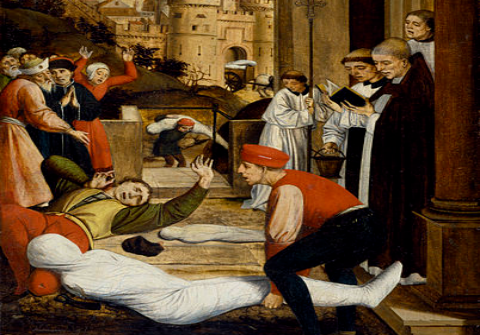
Fleas and rats are surely among the most detested of creatures. Gross and parasitic, it’s ever so natural to loathe them. But they’ve enjoyed a slight image makeover this week, as researchers came out with new findings that these maligned creatures were probably not the main vectors of Black Plague. Rather, it appears the disease was airborne. Sadly, this victory for fleas and rats is a setback for us humans, because it means the disease is a lot easier to spread than previously thought.
The plague—or Black Death—arrived in Europe from central Asia in the mid 14th century and wiped out about 75 million people in the span of just a few years. In some places like London, up to 60% of the population probably died, and some estimate that 1/3 to 1/2 of Europe’s denizens perished in the terrifying pandemic. This is truly the stuff of sci-fi horror films.
The disease caused traumatic upheaval in the social landscape of Europe, and made trade exceedingly difficult since people weren’t eager to exchange goods with a crazy-sick and infectious population. (Silver lining: with so much death, the demand for labor skyrocketed, somewhat improving the lot of laborers who could shop around for work).
The health community has long assumed that rats infected with the deadly bacteria spread the infection to humans through fleas. But increased access to records of the day indicates the disease spread too quickly for that explanation. Likewise, recent DNA analysis of 25 skeletons of plague victims uncovered last year in London indicates the disease was airborn, meaning the bacteria spread directly from human to human through coughing, sneezing and other fluids contamination. Like the common cold!
Think Black Death is long gone? Think again! The plague resides where all nightmarish diseases go for respite: Africa. And lest you conjecture that the current strain is more benign, researchers compared the strain from the Londoner skeletons with the strain recently responsible for killing 60 people in Madagascar: The DNA codes were an almost perfect match.
IT GETS WORSE! The plague is also present in the U.S. and caused 56 infections and seven deaths in western states within the past several years. These infections appear to have come from wild animals (although one death was that of a scientist working with the bacteria in a lab—again, cue sci-fi movie analogy), and did not spread to other people since antibiotic intervention in victims keeps the bacteria from becoming infectious.
But while antibiotics are currently effective at treating the infection and decreasing the airborn threat, the ability of many strains of bacteria to evolve beyond antibiotic capacity provides a lingering question about whether deadly diseases like Black Death could make a strong return.
If the plague does rear its ugly head here are a couple tips: stock up on face masks, and, if you’re a city dweller, come up with a contingency plan for rural living: Europeans who lived outside crowded urban areas fared far better against the plague. And many of the 14th century victims showed indicators of malnourishment that left them more vulnerable to infection, so eat up!
Image: commons.wikimedia.org.






